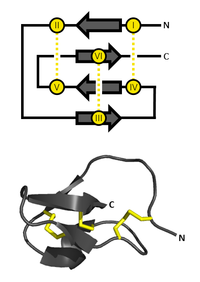
Tomato cystine-knot miniproteins possessing anti-angiogenic activity exhibit in vitro gastrointestinal stability, intestinal absorption and resistance to food industrial processing.
Sign Up to like & getrecommendations! Published in 2017 at "Food chemistry"
DOI: 10.1016/j.foodchem.2016.11.020
Abstract: The cystine-knot miniproteins present in tomato fruit (TCMPs) have been shown to exert anti-angiogenic effects by inhibiting endothelial cell migration and to display resistance to gastrointestinal proteolytic attack. To better define the pharmacological potential of… read more here.
Keywords: industrial processing; cystine knot; tomato; resistance ... See more keywords

‘Double-muscling’ and pelvic tilt phenomena in rabbits with the cystine-knot motif deficiency of myostatin on exon 3
Sign Up to like & getrecommendations! Published in 2019 at "Bioscience Reports"
DOI: 10.1042/bsr20190207
Abstract: Gene mutations at different gene sites will produce totally different phenotypes or biological functions in gene-edited animals. An allelic series of mutations in the myostatin (MSTN) gene can cause the ‘double-muscling’ phenotype. Although there have… read more here.
Keywords: knot motif; cystine knot; mstn rabbits; pelvic tilt ... See more keywords

Directed evolution identifies high-affinity cystine-knot peptide agonists and antagonists of Wnt/β-catenin signaling
Sign Up to like & getrecommendations! Published in 2022 at "Proceedings of the National Academy of Sciences of the United States of America"
DOI: 10.1073/pnas.2207327119
Abstract: Significance The Wnt pathway is critical for regeneration of tissues such as lung, skin, and intestine. Using a cystine-knot peptide (CKP) drug-discovery platform, we identified a class of peptide agonists that bind to the Wnt… read more here.
Keywords: knot peptide; signaling; cystine knot; peptide agonists ... See more keywords

Immunosuppressive, antimicrobial and insecticidal activities of inhibitor cystine knot peptides produced by teratocytes of the endoparasitoid wasp Cotesia flavipes (Hymenoptera: Braconidae).
Sign Up to like & getrecommendations! Published in 2022 at "Insect science"
DOI: 10.1111/1744-7917.13154
Abstract: Teratocytes are specialized cells released by parasitoid wasps into their hosts. They are known for producing regulatory molecules that aid the development of immature parasitoids. We have recently reported the primary structures of cystine-rich peptides,… read more here.
Keywords: cftick; inhibitor cystine; cystine knot; produced teratocytes ... See more keywords

Stability and Safety of Inhibitor Cystine Knot Peptide, GTx1-15, from the Tarantula Spider Grammostola rosea
Sign Up to like & getrecommendations! Published in 2021 at "Toxins"
DOI: 10.3390/toxins13090621
Abstract: Inhibitor cystine knot (ICK) peptides are knotted peptides with three intramolecular disulfide bonds that affect several types of ion channels. Some are proteolytically stable and are promising scaffolds for drug development. GTx1-15 is an ICK… read more here.
Keywords: inhibitor cystine; stability; gtx1; cystine knot ... See more keywords